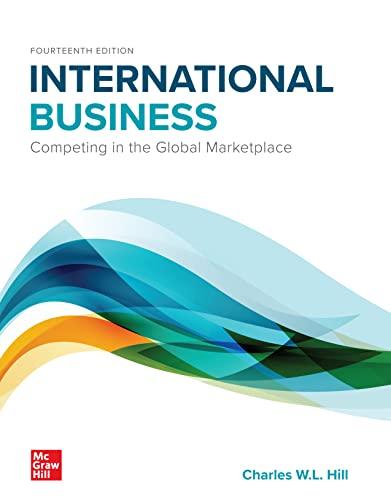Every day is a crazy juggling game, said Tom Andrews, the owner of lobster wholesaler Maine Coast
Question:
“Every day is a crazy juggling game,” said Tom Andrews, the owner of lobster wholesaler Maine Coast Company, back in 2016. Andrews founded the company in 2011 with a $1.5 million loan. By 2015, it was generating $43 million in revenues and growing at 20 to 30 percent a year. His customers were in places like Seoul, Madrid, San Francisco, and Shanghai. Foreign sales accounted for 55 percent of total revenues. China was the the strongest export market, making up 35 percent of sales. “They’re a seafood-consuming population,” he noted, “They’ve always been attracted to live seafood. As their middle class population grew, and wealth spread, more people were buying imported food. American lobsters caught on for celebrations like weddings and Chinese New Year.
Today, that’s one of their busiest times of year.”
His product is live and perishable. “We have to get it where it’s going in 48 to 60 hours,” he noted, “Any delay means it doesn’t get there alive.” Andrews had to worry about Homeland Security regulations, endless paperwork for exports to China, planes that didn’t take off on time, and so on. But all the same, Andrews was very successful.
By 2017, his company was generating $57 million in revenue, with more than one-fourth of those revenues going to China. On the basis of this export growth, the company took out a $1.4 million loan to expand its facilities.
It also hired two new salespeople, one fluent in Mandarin and the other in Cantonese, to grow the business in China.
Then in June 2018, just as Maine Coast Company’s new facilities were coming online, President Donald Trump imposed 25 percent tariffs on $50 billion of Chinese imports into America. On July 6, 2018, the Chinese responded with a number of retaliatory tariffs, including a 25 percent tariff on all lobsters exported from the United States to China. This wasn’t expected. In a 2018 interview, Andrews expressed his worries. “What happens if we lose 30 percent, 40 percent, even 50 percent of our market share? We have to keep paying the bank for that borrowed money. If we do have an impact on sales, it’s going to have a direct impact on jobs. That’s the only way we reduce our expenses.”
Andrews also noted that the tariffs gave a pricing advantage to Canadian lobster exports, which historically have been more expensive than Maine lobsters. Indeed, in addition to raising tariffs on American lobsters, the Chinese also reduced tariffs on lobster imports from Canada. To compound matters, in 2017 Canada signed a trade agreement with the European Union that over seven years would eliminate tariffs on 99 percent of trade between the two. By 2018, the EU had already eliminated its 8 percent tariff on Canadian live lobster and was scheduled to eliminate tariffs on frozen and processed lobsters that ranged from 6 percent to 20 percent. With U.S. exporters still facing tariffs, the Canadians now had a price advantage in Europe as well as China. “Between China and Europe, it’s a double whammy. It’s like taking body blow after body blow,” said Andrews.
Once he got over his shock, Andrews came up with a strategy for shoring up his sales. The plan was to grow the market in other Asian countries, including Singapore, Malaysia, Vietnam, Hong Kong, and Korea. He redirected the efforts of his two recently hired Chinesespeaking salespeople toward these markets. In addition, he increased the focus on selling to Chinese restaurants in the United States. The strategy helped, although sales stopped growing. The company’s 2018 revenues came in at about the same level as 2017 revenues.
While the American lobster industry hopes that China and America will resolve their differences, and that tariffs will come back down, Andrews and others recognize that the Chinese export business may not come back. Instead, many Chinese importers will stay with their new suppliers in Canada. As Andrews noted, “Canada does a good job of funding the seafood industry, and is putting money into airports to support that business. That infrastructure is not going away.” Even with the removal of tariffs on exports to China, “There will be a percentage of sales that will never come back,”* he said.
Case Discussion Questions 1. Why do you think Maine Lobster was so successful at growing its export business? What lessons are there here for other would-be exporters?
2. Generalizing from the experience of Maine Lobster, how do you think the protectionist policies adopted by the Trump administration impacted American exporters? What do you think will be the long-term impact of higher tariffs and trade tensions between the United States and China on Maine Lobster?
3. Maine Lobster reacted to the trade war with China by expanding into other Southeast Asian markets. Do you think this is a smart strategy?
What are the benefits here? Are there any risks you can see? Will this make up for the loss of Chinese business?
Step by Step Answer:

International Business Competing In The Global Marketplace
ISBN: 9781260387544
14th Edition
Authors: Charles Hill





